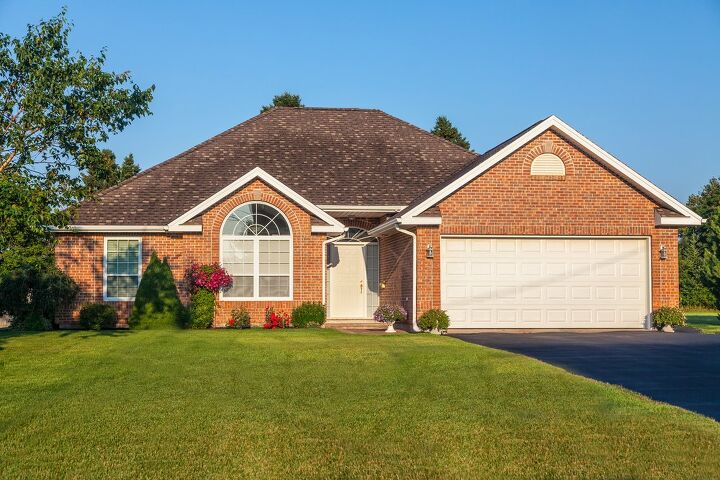How Much Wind Can A Brick House Withstand? (Find Out Now!)

Remember the story of “The Three Little Pigs”? The first two pigs built their homes out of straw and sticks, respectively, and the Big Bad Wolf made short work of their abodes with a bit of huffing and puffing. But the Wolf met his match in the third little pig, who built his house out of bricks and thus avoided the Wolf’s insatiable appetite for pork.
Most of us don’t have to worry about Big Bad Wolves huffing and puffing our houses down. But people who live, or are planning to live, in areas that are prone to heavy winds may wonder what kind of home would best stand up to such weather.
Brick houses may entail either solid brick construction or brick veneer over a wooden frame. Brick-veneered houses may be able to withstand winds up to 150 miles per hour, if the spacing between wooden wall studs is 16 inches wide. Houses with solid brick walls measuring two to four bricks thick are able to withstand winds better than a wooden-framed house, potentially up to 185 miles per hour or more.
Damage from high winds can occur in any type of construction. In order for a home to truly withstand high winds, homeowners should look at additional improvements and wind-resistant elements, such as sloped hip roofs, high-impact storm windows and doors, and methods of redirecting winds.
Do You Need Concrete, Brick, or Stone Pros?
Get free, zero-commitment quotes from pro contractors near you.

Types of Structures That Can Stand Up to Wind
Structures in areas that are prone to strong winds are usually built under specific construction guidelines that take wind load into consideration. Wind load refers to the pounds per square foot of pressure wind exerts on the exterior of a structure. The shape of the structure and the angle at which wind hits the structure work in tandem to determine wind load.
It is not uncommon in some areas of the tropics for people to build homes that are considered “hurricane proof” by building them out of concrete and in unique designs that reduce the effects of wind load. Bermuda, for example, follows specific building codes that require virtually all structures to be able to withstand wind speeds up to 110 miles per hour.
Concrete and steel structures can usually withstand the greatest amount of wind load, as the materials are among the strongest available for building construction. Such construction materials are not typically used in residential structures, however, due to potentially prohibitive costs. As such, homeowners in wind-prone areas may wonder if brick houses are a good alternative.
Are Brick Houses Stronger Than Other Types of Homes?
The strength of a brick house depends on the method of construction. Many homes that appear to be made of brick are actually sided with brick veneer. This means a wall that is one brick-width thick has been built and attached to the wood framing. Such brick walls create a certain aesthetic look and may offer some increased protection against wind. But other elements of the home’s construction may play more into the strength of the overall structure than the brick walls by themselves.
In order for a brick house to be stronger than a wooden house, the walls would need to be constructed of solid brick, perhaps up to four bricks thick, in an interlocking pattern. Such construction can sometimes be found in homes from centuries past, particularly in coastal areas of Northern Europe.
Unfortunately, there is no straightforward answer as to how strong a brick house is compared to wind load. Calculation of wind load all depends on construction, the thickness of walls, and the overall strength of the wind. Houses with brick veneers over studs spaced at 16 inches may be able to withstand winds up to 150 miles per hour, while solid brick homes may be able to stand up to wind as strong as 185 miles per hour or more.
Can a Brick House Withstand a Hurricane?
Whether a brick house can withstand a hurricane depends on how the overall structure is built.
With proper design and construction, a solid brick house could probably withstand winds from a hurricane up to a point. In some areas known for hurricanes, brick houses have stood for centuries against even direct hits from severe storms. Such solid brick homes may be more susceptible to damage from hail and flooding.
Homes that are built of wood with a layer of brick on the outside may be able to stand up to winds from a tropical storm or Category 1 or 2 hurricanes. But this would depend, again, on the overall methods of construction and other elements that may have been used to strengthen the house.
Can a Brick House Withstand a Tornado?
As with hurricanes, solid brick houses may stand a chance against F1 or F2 tornadoes. However, whether a house can stand up to a tornado often depends more on the roof than the walls.
A major reason why tornadoes cause so much damage is because of the extremely low air pressure that accompanies this violent storm. Homes and other structures that are leveled by tornadoes become victim to torn-off roofs and blown-out windows. These examples of structural damage weaken the overall integrity of the building. Unless the structure is solid brick or reinforced with steel framing, it is likely to sustain damage or destruction.
Find out how much wind a roof can withstand.
What If I Have a Wooden House? Can I Reinforce It?
Wooden homes can be reinforced, to a degree, to better withstand strong wind. Some simple and cost-effective upgrades include the installation of storm doors and windows. Another method would be to replace your existing siding with cement board siding.
Roof design can play a major role in how well a home stands up to wind. Sloped hip roofs and ridge vents can go a long way toward redirecting the flow of winds around your house. Proper installation of foam sealant under the roof can also help protect against wind damage.
In terms of a hurricane, there are several temporary ways you can reinforce your wooden home if you are in the path of a destructive tropical system. Hurricane shutters protect windows, and you can use hurricane plates and various forms of tie-downs to direct the wind load toward the foundation of your house.
Tornadoes are violent and often sudden, so it is difficult to prepare for one in the heat of the moment. However, if you live in a tornado-prone area, you can reinforce your wooden home with the installation of steel connectors that are connected to each other and the framing of the house with nails, bolts, and screws. This retrofit is expensive and difficult, but it creates a continuous load path for wind that helps reduce some of the damage a tornado may bring.
Do You Need Concrete, Brick, or Stone Pros?
Get free, zero-commitment quotes from pro contractors near you.

Related Questions
What is the strongest building material that can stand up to high winds?
Insulating Concrete Forms (ICFs) are probably among the strongest building materials available for residential construction. These walls are cast on-site during construction and reinforced with steel rods. If built properly, homes made with ICFs can withstand winds up to 250 miles per hour. In addition to their ability to hold up to strong winds, ICFs also help with heating and cooling costs, as they naturally help a home maintain a steady internal temperature, and also provide good soundproofing. Steel-framed homes are another option that may offer a bit more protection from wind. Like ICFs, steel-framed home construction also costs much more than traditional wood framing.
How can I build a more wind-resistant wooden house, if other build materials are out of my budget?
If you are building a wooden house in an area that is prone to high wind, there are several options available to make your home more wind-resistant. Homes shaped like hexagons or octagons can withstand a higher wind load, and also lend character and interest to your house. Roofing designs that include sloped hip roofs, as discussed above, are another easy way to build wind resistance into your house.Additionally, many wooden homes in wind prone areas are constructed using a type of barbed nail, rather than standard straight framing nails. These barbed nails are able to hold the home together a bit better under strong wind conditions.
Related Guide

We are a team of passionate homeowners, home improvement pros, and DIY enthusiasts who enjoy sharing home improvement, housekeeping, decorating, and more with other homeowners! Whether you're looking for a step-by-step guide on fixing an appliance or the cost of installing a fence, we've here to help.
More by Upgraded Home Team



























